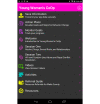An Evidence-Based HIV Risk-Reduction Intervention for Young African American Women in the US South Using mHealth: Adaptation and Development Study
- PMID: 35532978
- PMCID: PMC9127646
- DOI: 10.2196/34041
An Evidence-Based HIV Risk-Reduction Intervention for Young African American Women in the US South Using mHealth: Adaptation and Development Study
Abstract
Background: Young African American women have higher rates of sexually transmitted infections, including HIV, than those of young women of other racial and ethnic groups. Gender-, culture-, and age-specific interventions are needed to end the HIV epidemic. The Women's CoOp (WC) is an HIV risk-reduction intervention that is proven to be efficacious in various face-to-face formats.
Objective: This study aims to adapt the delivery method of an evidence-based intervention, the WC, from an in-person format to a self-guided mobile health (mHealth) format while ensuring that core elements are maintained for intervention comparability and fidelity.
Methods: Several adaptation phases were conducted by using the Personal Health Informatics and Intervention Toolkit (PHIT) as a guiding point to create the mobile app version of the WC. Throughout 5 phases, we established the implementation groundwork for the app; conducted formative research activities to test the initial draft of the app and obtain feedback; applied the PHIT toolkit programming structure to produce the mHealth version of the WC intervention; conducted usability testing and pretesting with interested parties, followed by in-house testing by WC interventionists and PHIT developers; and deployed the app to tablets and distributed it to study participants. The app underwent regular maintenance updates during the study.
Results: The team converted the seven elements of the WC as accurately as possible for comparability to determine efficacy in a mobile app format while changing little about the basic delivery methods. For instance, cue card presentations of the materials delivered by the intervention staff were presented within the app but with voice-over narration and in a self-guided format rather than being led by a staff member. Other aspects of the intervention did not lend themselves to such straightforward adaptation, such as hands-on condom proficiency practice and one-on-one goal-setting activities. In these cases, the subject matter experts and app developers worked together to find comparable analogs to be used within the app. Once developed, tested, and finalized, the mHealth WC app was deployed into local health departments as part of a randomized trial.
Conclusions: This systematic adaptation process created an accurate mHealth equivalent of an existing, in-person behavioral health intervention. Although participants' reception of the app during the formative developmental phase was overall positive, maintaining fidelity to the in-person delivery compromised the natural capabilities of a mobile app, such as further gamification, different types of interactivity, and integrated notifications and messaging, which could be helpful for participants' adherence to the intervention schedule. Given the development and implementation of the app, the next step is to examine the impact of the app and its efficacy in HIV and substance use risk-reduction.
Keywords: HIV; adaptation; e-learning; gamification; health risk behaviors; mHealth app; mobile apps; mobile phone; prevention; self-directed learning; substance use; violence; women; young women.
©Rebecca L Watkins, Felicia A Browne, Paul N Kizakevich, Brittni N Howard, Leslie B Turner, Randall Eckhoff, Wendee M Wechsberg. Originally published in JMIR Formative Research (https://formative.jmir.org), 09.05.2022.
Conflict of interest statement
Conflicts of Interest: None declared.
Figures
Similar articles
-
mHealth versus face-to-face: study protocol for a randomized trial to test a gender-focused intervention for young African American women at risk for HIV in North Carolina.BMC Public Health. 2018 Aug 6;18(1):982. doi: 10.1186/s12889-018-5796-8. BMC Public Health. 2018. PMID: 30081868 Free PMC article. Clinical Trial.
-
Centering Youth Voice in the Adaptation of an mHealth Intervention for Young Adults With HIV in South Texas, United States: Human-Centered Design Approach.JMIR Form Res. 2025 Apr 8;9:e60531. doi: 10.2196/60531. JMIR Form Res. 2025. PMID: 40198891 Free PMC article.
-
A Community-Engaged Approach to Creating a Mobile HIV Prevention App for Black Women: Focus Group Study to Determine Preferences via Prototype Demos.JMIR Mhealth Uhealth. 2020 Jul 24;8(7):e18437. doi: 10.2196/18437. JMIR Mhealth Uhealth. 2020. PMID: 32706723 Free PMC article.
-
Functional and Technical Aspects of Self-management mHealth Apps: Systematic App Search and Literature Review.JMIR Hum Factors. 2022 May 25;9(2):e29767. doi: 10.2196/29767. JMIR Hum Factors. 2022. PMID: 35612887 Free PMC article. Review.
-
mHealth for transgender and gender-expansive youth: harnessing gender-affirmative cross-disciplinary innovations to advance HIV prevention and care interventions.Mhealth. 2021 Apr 20;7:37. doi: 10.21037/mhealth-20-60. eCollection 2021. Mhealth. 2021. PMID: 33898606 Free PMC article. Review.
Cited by
-
Assessing Differences in mHealth Usability and App Experiences Among Young African American Women: Secondary Analysis of a Randomized Controlled Trial.JMIR Hum Factors. 2024 Apr 16;11:e51518. doi: 10.2196/51518. JMIR Hum Factors. 2024. PMID: 38625721 Free PMC article. Clinical Trial.
References
-
- HIV surveillance report. Centers for Disease Control and Prevention. 2019. [2021-12-30]. http://www.cdc.gov/hiv/library/reports/hiv-surveillance.html .
-
- NCHHSTP AtlasPlus. Centers for Disease Control and Prevention. 2018. [2021-12-30]. https://gis.cdc.gov/grasp/nchhstpatlas/tables.html .
-
- HIV in the United States by region. Centers for Disease Control and Prevention. 2020. [2022-01-03]. https://www.cdc.gov/hiv/pdf/statistics/overview/cdc-hiv-geographic-distr... .
-
- Sexually transmitted disease surveillance report. Centers for Disease Control and Prevention. 2019. [2022-01-03]. https://www.cdc.gov/std/statistics/2019/default.htm .
-
- Raiford JL, Herbst JH, Carry M, Browne FA, Doherty I, Wechsberg WM. Low prospects and high risk: structural determinants of health associated with sexual risk among young African American women residing in resource-poor communities in the south. Am J Community Psychol. 2014;54(3-4):243–50. doi: 10.1007/s10464-014-9668-9. http://europepmc.org/abstract/MED/25134798 - DOI - PMC - PubMed
Grants and funding
LinkOut - more resources
Full Text Sources
Medical






